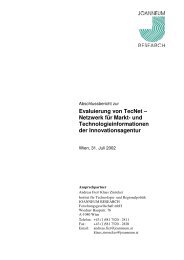roadMAP [PDF, 1.9 MB] - fteval
roadMAP [PDF, 1.9 MB] - fteval
roadMAP [PDF, 1.9 MB] - fteval
You also want an ePaper? Increase the reach of your titles
YUMPU automatically turns print PDFs into web optimized ePapers that Google loves.
Box 7<br />
The Finnish Technology Programmes – let’s remain flexible<br />
The funding in Technology programmes follows the general principles and criteria of RTDI funding<br />
defined by EU commission R&D framework, Government acts concerning grants and loans and funding<br />
principles and criteria defined by Tekes based on the previously mentioned framework and acts. Each<br />
programme can and usually does define additional criteria to focus and direct RTDI within the<br />
programme to a specific direction. These additional criteria are defined in consultation with key<br />
stakeholders. Furthermore, there are guidelines for programmes for defining IPR rules and contracts.<br />
Practices related to selection procedures, monitoring practices, etc. are mostly tacit knowledge, not<br />
documented in detail. This has been partly intentional to allow for a sufficient degree of innovativeness.<br />
Most of these are currently documented for each programme separately to allow for transparency and<br />
exchange of good practice, but still the level of general programme guidelines is intentionally left to the<br />
level of guidance and check listing, not taken to the level of detailed instructions, rules or procedures.<br />
There is a manual of about 15 pages for tasks of the programme manager and the steering group. The<br />
rules are flexible, just giving an orientation and supporting the programme steering. The necessity to<br />
adapt the procedures and programme structure to the specific objectives and the structure of the<br />
corresponding sector is emphasised. Additionally, there exists a general guideline for evaluations of<br />
technology programmes.<br />
4.6 International influence and opening up of national programmes<br />
4.6.1 International influences and pedigrees<br />
In the evolving European Research Area (ERA, European Commission 2000), international<br />
influence and interplay becomes more and more important and takes place at different levels,<br />
for example more international research alliances and networks, the opening up of national<br />
programmes, the involvement of foreign peers in selection procedures etc. However, it is<br />
essential to take the importance of the framework conditions into account: As Good and even<br />
Best Practice approaches grew highly popular namely in the OECD (OECD 1998a, 1998b,<br />
OECD 1999b) and EU context and it became fashionable to import foreign programme<br />
concepts, there is a certain danger to underestimate different legal, organisational, cultural<br />
frameworks and questions like budgets, size, past success etc. (see also chapter 8 on<br />
governance). Nevertheless especially MAPs need careful comparisons on management level<br />
due to their complexity and their specific problems as for example the lack of a dominant actor<br />
and the careful balancing of the different actor interests.<br />
A further entrance door for international influence in the MAP context is the strong involvement<br />
of foreign peers in ex ante, monitoring and ex post evaluations which is caused not only by<br />
scientific necessities or country size but also simply by the fact that MAPs are very often large<br />
programmes addressing the most relevant national actors so that competent peers have to be<br />
looked for abroad. A further advantage of foreign peers is that they can feed in their experience,<br />
often stemming from their own MAPs.<br />
<strong>roadMAP</strong> 31


![roadMAP [PDF, 1.9 MB] - fteval](https://img.yumpu.com/21079876/36/500x640/roadmap-pdf-19-mb-fteval.jpg)

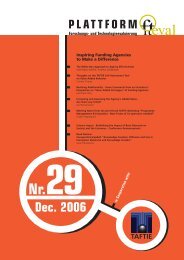
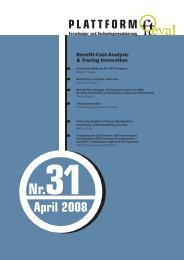
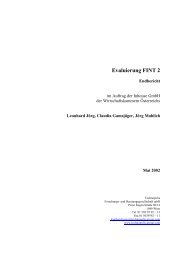
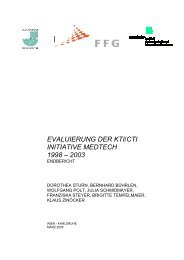
![GuggenbergeronBoku [PDF, 73.4 KB] - fteval](https://img.yumpu.com/21024081/1/184x260/guggenbergeronboku-pdf-734-kb-fteval.jpg?quality=85)
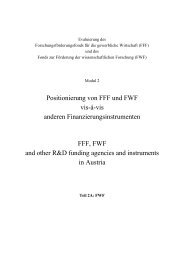

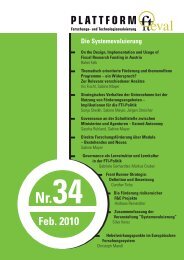
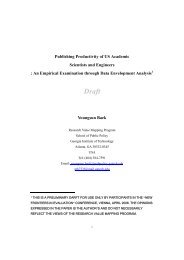
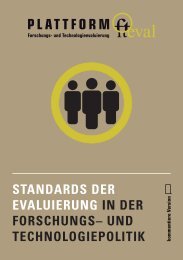
![ITF_Energietechnik [PDF, 39.6 KB] - fteval](https://img.yumpu.com/20959076/1/184x260/itf-energietechnik-pdf-396-kb-fteval.jpg?quality=85)
![Evaluation Standards [PDF, 120.8 KB] - fteval](https://img.yumpu.com/20931509/1/184x260/evaluation-standards-pdf-1208-kb-fteval.jpg?quality=85)
